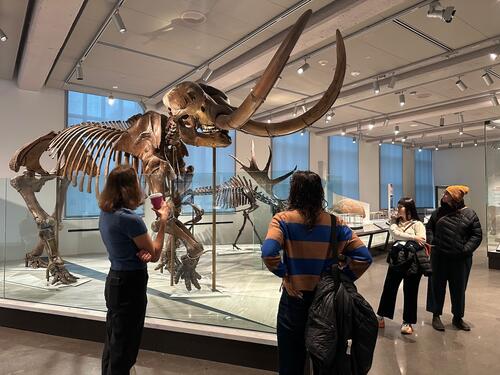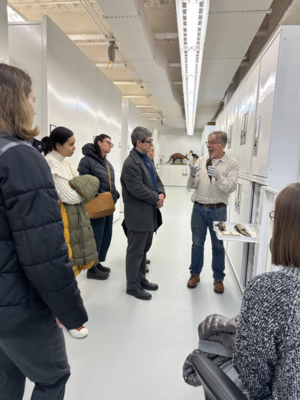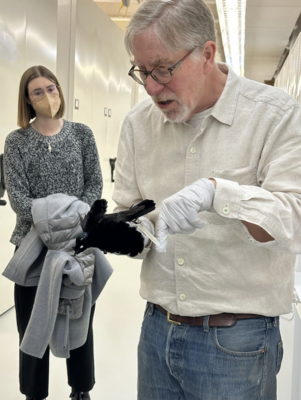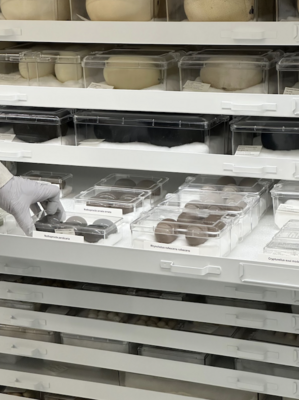
February 25, 2025
On January 31st, graduate students, postdoctoral associates, and faculty associated with Yale Environmental Humanities gathered for a special tour of the newly renovated Yale Peabody Museum. Guided by David Heiser, Director of Student Programs, and Richard Prum, William Robertson Coe Professor of Ornithology, Ecologyand Evolutionary Biology, the tour—organized by Faculty Director Paul Sabin and Graduate Coordinator Colton Klein—offered a behind-the-scenes look at the museum’s updated exhibition spaces as well as its Vertebrate Zoology Collection.
A Walk Through Renovated Exhibition Spaces with David Heiser
Heiser, who also led the Environmental Humanities Horse Island Field Trip last September, steered the group through the museum’s redesigned permanent exhibitions, including The Human Footprint, where objects make visible how human activities have come to shape environments all over the planet. A highlight of the exhibition was the towering, ten-foot-tall American mastodon, discovered in New York. Heiser described the specimen as a “sub-fossil” due to its relatively recent age and noted the role of human hunting in the extinction of many late Pleistocene and early Holocene megafauna.
Another key stop on the renovation tour was the History of Science and Technology exhibition, a newly curated display area that formerly housed staff offices. Heiser emphasized the importance of this space, explaining that this is “the first time in the museum’s history that we’ve had a dedicated, permanent space for the history of science and technology.” He also introduced attendees to the museum’s brand-new classroom facilities, noting that faculty are encouraged to arrange collection visits for object-based teaching at the Peabody.
Behind the Scenes in the Vertebrate Zoology Collection with Richard Prum

Following the renovation tour with Heiser, attendees were granted a rare look at the Vertebrate Zoology Collection, where Richard Prum, a member of the Yale Environmental Humanities Steering Committee, shared insights into the materiality of bird specimens.
“This is where we celebrate materiality,” Prum stated as he introduced a selection of specimens, including quetzals, penguins, passenger pigeons, loons, a male bird of paradise, and several species of manakins, including the opal-crowned manakin—a particular favorite among attendees.
One of the key discussions centered on color in birds and what can be learned from studying the materiality of color. Prum demonstrated how variations in feather pigmentation can reveal critical biological and ecological information. He showcased two specimens—one with a red crown and another with a canary-yellow crown—and explained how researchers can determine missing dietary enzymes based on such differences. He also shared a striking fact: birds do not produce blue pigment. Instead, all blue hues in birds result from light waves interacting with the feathers and their protein molecules, not pigment.
Using the opal-crowned manakin as an example, Prum explained how its crown interacts with light in a manner similar to the gemstone opal, due to nanostructural similarities.

Bridging the Natural Sciences and the Humanities
Throughout the visit, Prum highlighted the deep connections between ornithology and the humanities. He emphasized that contemporary ornithology is moving beyond traditional disciplinary boundaries in the biological sciences: “We’re not in an interdisciplinary phase, but an undisciplined phase in ornithology.” He introduced the concept of the “posthuman aesthetic framework,”
which accounts for the ways both humans and birds participate in shaping the category of beauty without centering human perspectives.
Prum also discussed how research into feather pigmentation and mate selection in birds has led to groundbreaking feminist scientific discoveries. “These discoveries demonstrate that sexual autonomy and choice matter in nature,” he explained, “not as political concepts but as natural consequences of evolution.”
The discussion concluded with a reflection on the role of museum registration and collection management practices, especially regarding specimen labels. Without proper labeling, Prum noted, a specimen risks becoming merely a curiosity rather than a valuable piece of scientific data. He demonstrated how labeling practices have evolved over time, comparing sparsely detailed labels from the 1930s to the much richer records kept today. Modern labels can include information on stomach contents, dietary enzymes, molecular specimens, and isotope data, opening up vast new avenues for ecological and climate change research.

Looking Ahead with Collections-Based Research
The Peabody Museum’s renovation and its expanded commitment to hands-on, interdisciplinary research and education provide an exciting opportunity for the Yale Environmental Humanities community. This visit underscored the value of material- and object-based study in bridging the natural sciences and humanities, fostering new conversations between disciplines and across campus.